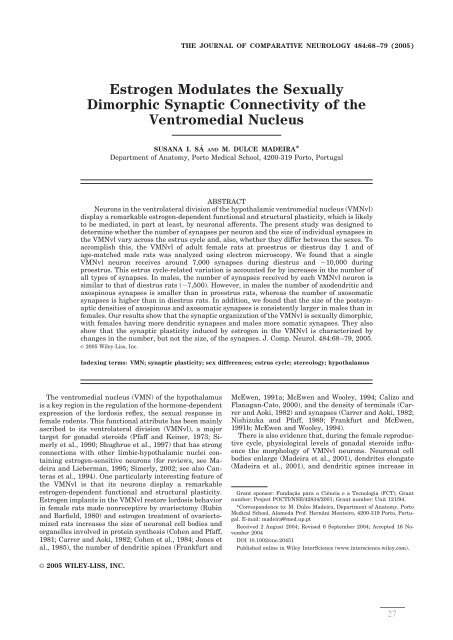Susana Isabel Ferreira da Silva de Sá ESTROGÉNIOS E ...
Susana Isabel Ferreira da Silva de Sá ESTROGÉNIOS E ...
Susana Isabel Ferreira da Silva de Sá ESTROGÉNIOS E ...
Create successful ePaper yourself
Turn your PDF publications into a flip-book with our unique Google optimized e-Paper software.
Estrogen Modulates the Sexually<br />
Dimorphic Synaptic Connectivity of the<br />
Ventromedial Nucleus<br />
SUSANA I. SÁ AND M. DULCE MADEIRA*<br />
Department of Anatomy, Porto Medical School, 4200-319 Porto, Portugal<br />
ABSTRACT<br />
Neurons in the ventrolateral division of the hypothalamic ventromedial nucleus (VMNvl)<br />
display a remarkable estrogen-<strong>de</strong>pen<strong>de</strong>nt functional and structural plasticity, which is likely<br />
to be mediated, in part at least, by neuronal afferents. The present study was <strong>de</strong>signed to<br />
<strong>de</strong>termine whether the number of synapses per neuron and the size of individual synapses in<br />
the VMNvl vary across the estrus cycle and, also, whether they differ between the sexes. To<br />
accomplish this, the VMNvl of adult female rats at proestrus or diestrus <strong>da</strong>y 1 and of<br />
age-matched male rats was analyzed using electron microscopy. We found that a single<br />
VMNvl neuron receives around 7,000 synapses during diestrus and 10,000 during<br />
proestrus. This estrus cycle-related variation is accounted for by increases in the number of<br />
all types of synapses. In males, the number of synapses received by each VMNvl neuron is<br />
similar to that of diestrus rats (7,500). However, in males the number of axo<strong>de</strong>ndritic and<br />
axospinous synapses is smaller than in proestrus rats, whereas the number of axosomatic<br />
synapses is higher than in diestrus rats. In addition, we found that the size of the postsynaptic<br />
<strong>de</strong>nsities of axospinous and axosomatic synapses is consistently larger in males than in<br />
females. Our results show that the synaptic organization of the VMNvl is sexually dimorphic,<br />
with females having more <strong>de</strong>ndritic synapses and males more somatic synapses. They also<br />
show that the synaptic plasticity induced by estrogen in the VMNvl is characterized by<br />
changes in the number, but not the size, of the synapses. J. Comp. Neurol. 484:68–79, 2005.<br />
© 2005 Wiley-Liss, Inc.<br />
In<strong>de</strong>xing terms: VMN; synaptic plasticity; sex differences; estrus cycle; stereology; hypothalamus<br />
The ventromedial nucleus (VMN) of the hypothalamus<br />
is a key region in the regulation of the hormone-<strong>de</strong>pen<strong>de</strong>nt<br />
expression of the lordosis reflex, the sexual response in<br />
female ro<strong>de</strong>nts. This functional attribute has been mainly<br />
ascribed to its ventrolateral division (VMNvl), a major<br />
target for gona<strong>da</strong>l steroids (Pfaff and Keiner, 1973; Simerly<br />
et al., 1990; Shughrue et al., 1997) that has strong<br />
connections with other limbic-hypothalamic nuclei containing<br />
estrogen-sensitive neurons (for reviews, see Ma<strong>de</strong>ira<br />
and Lieberman, 1995; Simerly, 2002; see also Canteras<br />
et al., 1994). One particularly interesting feature of<br />
the VMNvl is that its neurons display a remarkable<br />
estrogen-<strong>de</strong>pen<strong>de</strong>nt functional and structural plasticity.<br />
Estrogen implants in the VMNvl restore lordosis behavior<br />
in female rats ma<strong>de</strong> nonreceptive by ovariectomy (Rubin<br />
and Barfield, 1980) and estrogen treatment of ovariectomized<br />
rats increases the size of neuronal cell bodies and<br />
organelles involved in protein synthesis (Cohen and Pfaff,<br />
1981; Carrer and Aoki, 1982; Cohen et al., 1984; Jones et<br />
al., 1985), the number of <strong>de</strong>ndritic spines (Frankfurt and<br />
© 2005 WILEY-LISS, INC.<br />
THE JOURNAL OF COMPARATIVE NEUROLOGY 484:68–79 (2005)<br />
McEwen, 1991a; McEwen and Wooley, 1994; Calizo and<br />
Flanagan-Cato, 2000), and the <strong>de</strong>nsity of terminals (Carrer<br />
and Aoki, 1982) and synapses (Carrer and Aoki, 1982;<br />
Nishizuka and Pfaff, 1989; Frankfurt and McEwen,<br />
1991b; McEwen and Wooley, 1994).<br />
There is also evi<strong>de</strong>nce that, during the female reproductive<br />
cycle, physiological levels of gona<strong>da</strong>l steroids influence<br />
the morphology of VMNvl neurons. Neuronal cell<br />
bodies enlarge (Ma<strong>de</strong>ira et al., 2001), <strong>de</strong>ndrites elongate<br />
(Ma<strong>de</strong>ira et al., 2001), and <strong>de</strong>ndritic spines increase in<br />
Grant sponsor: Fun<strong>da</strong>ção para a Ciência e a Tecnologia (FCT); Grant<br />
number: Project POCTI/NSE/42834/2001; Grant number: Unit 121/94.<br />
*Correspon<strong>de</strong>nce to: M. Dulce Ma<strong>de</strong>ira, Department of Anatomy, Porto<br />
Medical School, Alame<strong>da</strong> Prof. Hernâni Monteiro, 4200-319 Porto, Portugal.<br />
E-mail: ma<strong>de</strong>ira@med.up.pt<br />
Received 2 August 2004; Revised 6 September 2004; Accepted 16 November<br />
2004<br />
DOI 10.1002/cne.20451<br />
Published online in Wiley InterScience (www.interscience.wiley.com).<br />
27

















